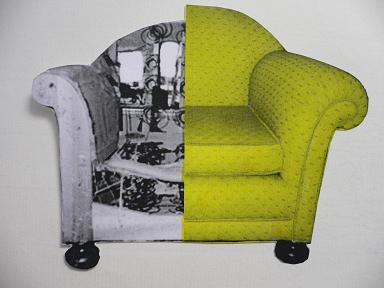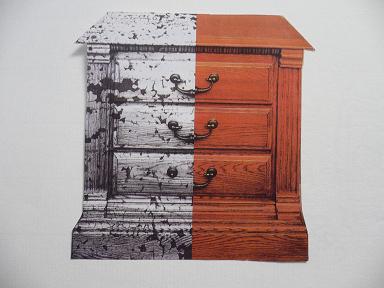RENAISSANCE FURNITURE RESTORATION
"They Said It Couldn't Be Done"
Phone: (415) 587-3416
E-mail: 1600ocean@gmail.com
HOW TO CARE FOR YOUR FURNITURE
THE BASICS
Wood furniture and cabinets are coated with a thin plastic-like film called a “finish,” the purpose of which is to protect the wood from moisture and stains and enhance the coloring. Caring for your finished furniture is a simple process of protecting this finish from the two elements that damage it most: light and abuse.
Bright ultra-violet light, especially direct sunlight, causes colors to fade and finishes cracking and crazing. To protect your furniture from UV-light damage, place it away from windows, make use of curtains and shades, and cover critical surfaces such as tabletops when not in use.
Abuse can take many forms, including abrasion from coarse or hard objects and excessive contact with heat or liquids. Using pads, coasters, place mats, table pads and tablecloths will help reduce damage from abuse. Applying a furniture polish or paste wax can also help by making the surface slick, which reduces scratching.
HOW TO CHOOSE FURNITURE POLISH
Choosing a furniture-care product is easy because there are only four types of them, based on the main ingredient.
Petroleum-distillate solvent is the primary ingredient in most polishes and is often referred to as “oil.” Actually, it is a form of mineral spirits with a slower evaporation rate. This liquid adds shine and scratch resistance only until evaporates, which usually happened within a few hours. It also removes grease and wax and helps pick up dust, but it has no cleaning effect on water-soluble dirt such as dried soft-drink spills or sticky fingerprints. Choose a petroleum-distillate based polish if you want an inexpensive, pleasant smelling liquid to aid in dust removal.
Water is added to many polishes because it is a great cleaner for most types of dirt. When water is combined with petroleum-distillate solvent to make an “emulsion polish,” the polish appears milky-white when first applied. Emulsion polish has advantage over petroleum-distillate based polish when you need to clean both grease and water-soluble dirt. Choose an emulsion polish if you want a polish that aids in dusting and cleans well.
Silicone is very slick synthetic oil that produces the appearance of great depth in wood and remains on the surface for a week or longer. Silicone is usually inert and causes no damage to the finish or the wood, but it does cause refinishing problems that require extra effort to overcome. As a result, many refinishers discourage the use of silicone polishes. You can identify silicone polishes by the telltale marking they leave when you drag your finger over a surface – even after several days. Choose a silicone polish if you want long lasting shine and scratch resistance along with a dusting aid.
Wax is solid at room temperature and does not evaporate from the furniture’s surface, so there is no reason to apply it often. Sometimes wax is added to liquid polishes, what make it easier to apply. Paste wax is the most permanent furniture-care product and also the most difficult to apply because of the extra effort required to remove the excess. On deteriorated surfaces, wax has the advantage of not highlighting cracking and crazing as do liquid polishes. Choose a wax polishes if you want fairly permanent shine and scratch resistance on old, deteriorated finishes, or on newer finishes without using a silicone polish.
CARING FOR ANTIQUE FURNITURE
Unless recently refinished, the finish of antique furniture is typically dull and cracked. In addition, the joints holding the parts together may loose and veneer may be lifting. Overall, this furniture is just more fragile than new furniture, and you should treat it as such.
All the information located on this page applies also to antique furniture, only more so. In other words, it is more important to keep the furniture away from bright light, and it is more important to protect the finish from scratches because it is brittle and will damage easily. Paste wax does the best.
It is also best to keep the relative humidity in your home as constant as possible, because wide swings cause further loosening of joints and lifting of veneer. Beyond this simple care, no further steps need to be taken – other than to enjoy your furniture.
FABRIC CLEANING INSTRUCTIONS Credit: “How to Care of Your Furniture,” Bob Flexner, 2003
THE BASICS
Wood furniture and cabinets are coated with a thin plastic-like film called a “finish,” the purpose of which is to protect the wood from moisture and stains and enhance the coloring. Caring for your finished furniture is a simple process of protecting this finish from the two elements that damage it most: light and abuse.
Bright ultra-violet light, especially direct sunlight, causes colors to fade and finishes cracking and crazing. To protect your furniture from UV-light damage, place it away from windows, make use of curtains and shades, and cover critical surfaces such as tabletops when not in use.
Abuse can take many forms, including abrasion from coarse or hard objects and excessive contact with heat or liquids. Using pads, coasters, place mats, table pads and tablecloths will help reduce damage from abuse. Applying a furniture polish or paste wax can also help by making the surface slick, which reduces scratching.
HOW TO CHOOSE FURNITURE POLISH
Choosing a furniture-care product is easy because there are only four types of them, based on the main ingredient.
Petroleum-distillate solvent is the primary ingredient in most polishes and is often referred to as “oil.” Actually, it is a form of mineral spirits with a slower evaporation rate. This liquid adds shine and scratch resistance only until evaporates, which usually happened within a few hours. It also removes grease and wax and helps pick up dust, but it has no cleaning effect on water-soluble dirt such as dried soft-drink spills or sticky fingerprints. Choose a petroleum-distillate based polish if you want an inexpensive, pleasant smelling liquid to aid in dust removal.
Water is added to many polishes because it is a great cleaner for most types of dirt. When water is combined with petroleum-distillate solvent to make an “emulsion polish,” the polish appears milky-white when first applied. Emulsion polish has advantage over petroleum-distillate based polish when you need to clean both grease and water-soluble dirt. Choose an emulsion polish if you want a polish that aids in dusting and cleans well.
Silicone is very slick synthetic oil that produces the appearance of great depth in wood and remains on the surface for a week or longer. Silicone is usually inert and causes no damage to the finish or the wood, but it does cause refinishing problems that require extra effort to overcome. As a result, many refinishers discourage the use of silicone polishes. You can identify silicone polishes by the telltale marking they leave when you drag your finger over a surface – even after several days. Choose a silicone polish if you want long lasting shine and scratch resistance along with a dusting aid.
Wax is solid at room temperature and does not evaporate from the furniture’s surface, so there is no reason to apply it often. Sometimes wax is added to liquid polishes, what make it easier to apply. Paste wax is the most permanent furniture-care product and also the most difficult to apply because of the extra effort required to remove the excess. On deteriorated surfaces, wax has the advantage of not highlighting cracking and crazing as do liquid polishes. Choose a wax polishes if you want fairly permanent shine and scratch resistance on old, deteriorated finishes, or on newer finishes without using a silicone polish.
CARING FOR ANTIQUE FURNITURE
Unless recently refinished, the finish of antique furniture is typically dull and cracked. In addition, the joints holding the parts together may loose and veneer may be lifting. Overall, this furniture is just more fragile than new furniture, and you should treat it as such.
All the information located on this page applies also to antique furniture, only more so. In other words, it is more important to keep the furniture away from bright light, and it is more important to protect the finish from scratches because it is brittle and will damage easily. Paste wax does the best.
It is also best to keep the relative humidity in your home as constant as possible, because wide swings cause further loosening of joints and lifting of veneer. Beyond this simple care, no further steps need to be taken – other than to enjoy your furniture.
FABRIC CLEANING INSTRUCTIONS Credit: “How to Care of Your Furniture,” Bob Flexner, 2003






